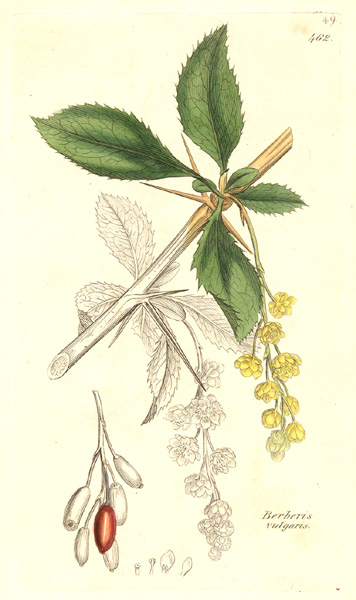
Berberis vulgaris (L)
 Synonyms: Berberidis cortex, Berberis
dumetorum (Gouan.), European barberry, common barberry, berbery, jaundice
berry, pepperidge, pepperidge bush, pipperidge bush, sowberry
Synonyms: Berberidis cortex, Berberis
dumetorum (Gouan.), European barberry, common barberry, berbery, jaundice
berry, pepperidge, pepperidge bush, pipperidge bush, sowberry
Order: Berberidaceae
Description: Berberis is a thorned deciduous shrub with yellow wood growing up to 2.5m in height. It has arched and hanging branches, with clusters of alternate pale green, stiff and toothed leaves. The small yellow flowers, which have an unpleasant smell, occur in elegant drooping racemes. These later give way to small red oblong berries. It grows in thickets and open woods over Europe, Asia and the northeast and west of North America. The species has been introduced to Britain.
Parts used: Bark of root or stem
Collection: The roots are unearthed in March or November and the stem bark is collected at the same time.
Constituents: Isoquinoline alkaloids (including berberine, oxyacanthine, palmatine, columbamine) chelidonic acid, tannins, wax.
Actions: cholagogue and hepatic stimulant, antemetic, bitter digestive tonic, tonic to spleen causing splenic contractions, laxative, emmenagogue
Indications: cholecystitis, cholelithiasis, jaundice, Leishmaniasis, malaria.
Therapeutics and Pharmacology: Berberis is an excellent remedy for correcting liver function and promoting bile flow. It is used in debilitating conditions marked by poor digestive function and a history of dietary or alcohol abuse, or excessive exposure to drugs, chemicals or industrial pollutants. It is indicated in congestive jaundice, inflammation of the gall bladder and gallstones. As a bitter tonic with mild laxative effects, it is used with weak or debilitated people to strengthen and cleanse the system. It also appears to be able to reduce an enlarged spleen. It acts against malaria and is effective in the treatment of protozoal infection due to Leishmania spp. Berberine it is highly bactericidal, amoeboidal and trypanocidal. It is active in vitro and in animals against cholera. It makes a useful compress for inflammatory eye conditions such as blepharitis and conjunctivitis. It may also be used to treat dysmenorrhoea and labour pains.
Combinations: In gall bladder diseases it combines well with Chionanthus and Leptandra
Caution: Avoid during pregnancy as the alkaloid berberine is a uterine stimulant. Excessive doses should be avoided.
Preparation and Dosage: (thrice daily)
Regulatory Status GSL
Dried bark: 1-2g or by decoction
Liquid Extract: 1:1 in 25% alcohol, 2-3ml
Tincture: 1:10 in 60% alcohol, 2-4ml
Additional Comments: The Italians call the barberry Holy Thorn, because it is thought to have formed part of the Crown of Thorns. Berberis is the Arabic name for the fruit. The berries were pickled in the past and had various culinary uses. In the Far East, berberine-containing plants are specifically used for bacillary dysentery and diarrhoea. The roots produce a yellow dye. Barberry became unpopular with farmers when it was discovered to be a host plant for the wheat rust fungus that decimated crops in the 19th century.
Bibliography
BHMA 1983 British Herbal Pharmacopoeia, BHMA, Bournemouth.
Grieve, M. 1931 A Modern Herbal, (ed. C.F. Leyel 1985), London.
Hoffmann, D. 1990 The New Holistic Herbal, Second Edition, Element, Shaftesbury.
Lust, J. 1990 The Herb Book, Bantam, London.
Mabey, R. (ed.) 1991 The Complete New Herbal, Penguin, London.
Mills, S.Y. 1993 The A-Z of Modern Herbalism, Diamond Books, London.
Mills, S.Y. 1993 The Essential Book of Herbal Medicine, Penguin, London (First published in 1991 as Out of the Earth, Arkana)
Polunin, M. and Robbins, C. 1992 The Natural Pharmacy, Dorling Kindersley, London.
Weiss, R.F. 1991 Herbal Medicine, Beaconsfield Arcanum, Beaconsfield.
Wren, R.C. 1988 Potter's New Cyclopaedia of Botanical Drugs and Preparations, C.W.Daniel, Saffron Walden.










